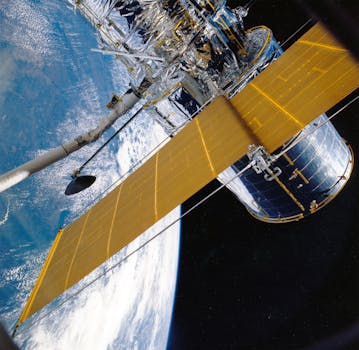
Beyond Earth: How Recent Advances Are Shaping Satellite Telecommunications
Satellite Telecommunications: The Next Frontier
Satellite Telecommunications is an exciting field that has been rapidly evolving in recent years. With the increasing demand for global connectivity, satellite telecommunications have become a vital component of modern communication systems. Recent advances in space technology have paved the way for more efficient, reliable, and cost-effective satellite telecommunications. In this article, we will delve into the latest developments in satellite telecommunications and their significance in shaping the future of communication beyond Earth.
One of the key drivers of innovation in satellite telecommunications is the development of new satellite constellations. These constellations comprise hundreds or even thousands of small satellites that work together to provide global coverage and high-speed connectivity. Companies like SpaceX, OneWeb, and Amazon’s Kuiper Systems are leading the charge in this area, with plans to launch thousands of satellites into low Earth orbit (LEO) in the coming years. These constellations will enable faster, more reliable, and more affordable internet access for millions of people around the world, particularly in remote and underserved areas.
Advances in Satellite Technology
Recent advances in satellite technology have been instrumental in shaping the future of satellite telecommunications. One of the most significant developments is the use of phased array antennas, which enable satellites to steer and shape their beams electronically. This technology allows for more efficient use of satellite bandwidth, increased capacity, and improved signal quality. Additionally, the development of high-throughput satellites (HTS) has enabled the provision of high-speed internet services, with speeds of up to 100 Gbps. These advances have made satellite telecommunications a more viable option for a wide range of applications, from broadband internet access to mobile networks and IoT connectivity.
Another area of innovation is the use of advanced propulsion systems, such as electric propulsion and Hall effect thrusters. These systems provide more efficient and longer-lasting propulsion, enabling satellites to stay in orbit for longer periods and reducing the need for costly and complex launch vehicles. Furthermore, the development of reusable launch vehicles, like SpaceX’s Falcon 9, has significantly reduced the cost of accessing space, making it more feasible for companies to launch satellites and other spacecraft.
Impact on the Industry
The recent advances in satellite telecommunications are having a significant impact on the industry. One of the most notable effects is the increasing competition and innovation in the market. With the entry of new players, such as SpaceX and OneWeb, the traditional satellite industry is being disrupted, and new business models are emerging. The use of satellite constellations and HTS is also enabling new applications and services, such as satellite-based 5G networks and IoT connectivity. These developments are creating new opportunities for growth and revenue streams for satellite operators, service providers, and equipment manufacturers.
In addition, the advances in satellite telecommunications are also having a positive impact on society. Satellite-based connectivity is enabling people in remote and underserved areas to access essential services, such as education, healthcare, and financial services. It is also providing critical connectivity for emergency response and disaster relief efforts, as well as for environmental monitoring and climate change research. As the satellite industry continues to evolve, we can expect to see even more innovative applications and services emerge, transforming the way we communicate and interact with each other and the world around us.
Conclusion
In conclusion, recent advances in satellite telecommunications are transforming the way we communicate beyond Earth’s boundaries. The development of new satellite constellations, advances in satellite technology, and innovation in propulsion systems are all contributing to a more efficient, reliable, and cost-effective satellite telecommunications industry. As the industry continues to evolve, we can expect to see new applications, services, and business models emerge, creating new opportunities for growth, revenue, and societal impact. With the increasing demand for global connectivity, satellite telecommunications will play an essential role in shaping the future of communication, and it is exciting to think about what the next generation of satellite technologies will bring.



